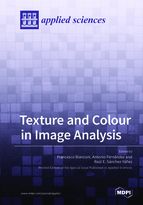Texture and Colour in Image Analysis
A special issue of Applied Sciences (ISSN 2076-3417). This special issue belongs to the section "Computing and Artificial Intelligence".
Deadline for manuscript submissions: closed (25 April 2020) | Viewed by 67028
Special Issue Editors
Interests: computer vision; machine learning; image processing; colour; texture; biomedical image analysis; radiomics
Special Issues, Collections and Topics in MDPI journals
Interests: image processing; machine learning; computer vision; texture analysis
Special Issues, Collections and Topics in MDPI journals
Special Issue Information
Dear Colleagues,
Colour and texture are among the visual properties that mostly determine the appearance of objects, materials and scenes. As a consequence, the analysis of colour and texture plays a fundamental role in a wide range of applications, for instance, object recognition, scene understanding, materials classification, defect detection, biometric identification, content-based multimedia retrieval, remote sensing and computer-assisted diagnosis.
The field is undergoing rapid changes. While the “hand-designed” paradigm was the leading approach until not too long ago, during the last few years, research has been shifting towards data-driven models, where the visual features are no longer designed “a priori”, but learned from the data (deep learning).
This Special issue wants to provide a forum to discuss strategies, challenges and perspectives in this field of research. We are soliciting original contributions as well as thorough reviews and comprehensive comparative evaluations. We particularly encourage the submission of theoretical works investigating the mathematical underpinnings of colour and texture analysis.
Prof. Francesco Bianconi
Prof. Dr. Antonio Fernández
Prof. Raúl E. Sánchez-Yáñez
Guest Editors
Manuscript Submission Information
Manuscripts should be submitted online at www.mdpi.com by registering and logging in to this website. Once you are registered, click here to go to the submission form. Manuscripts can be submitted until the deadline. All submissions that pass pre-check are peer-reviewed. Accepted papers will be published continuously in the journal (as soon as accepted) and will be listed together on the special issue website. Research articles, review articles as well as short communications are invited. For planned papers, a title and short abstract (about 100 words) can be sent to the Editorial Office for announcement on this website.
Submitted manuscripts should not have been published previously, nor be under consideration for publication elsewhere (except conference proceedings papers). All manuscripts are thoroughly refereed through a single-blind peer-review process. A guide for authors and other relevant information for submission of manuscripts is available on the Instructions for Authors page. Applied Sciences is an international peer-reviewed open access semimonthly journal published by MDPI.
Please visit the Instructions for Authors page before submitting a manuscript. The Article Processing Charge (APC) for publication in this open access journal is 2400 CHF (Swiss Francs). Submitted papers should be well formatted and use good English. Authors may use MDPI's English editing service prior to publication or during author revisions.
Keywords
- Mathematics of colour and texture
- Perceptual models of colour and texture
- Hand-designed image descriptors
- Convolutional networks and deep learning
- Datasets, comparative evaluations and benchmarks
- Materials classification
- Biomedical image analysis
- Colour and texture in the arts and cultural heritage
- Remote sensing








